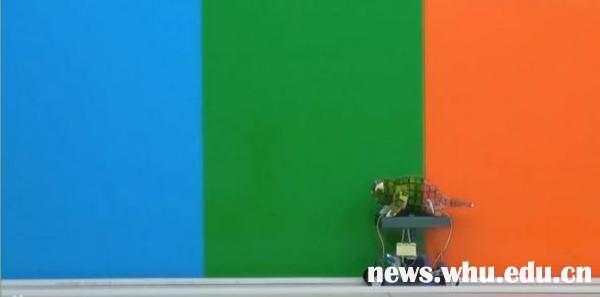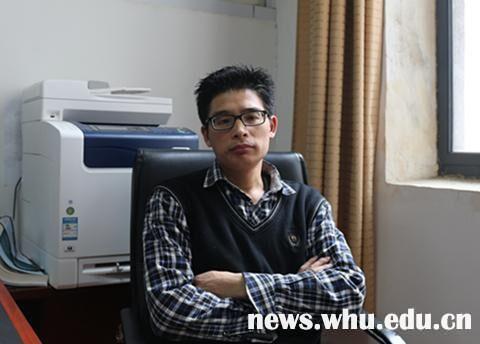Recently, a short video about “artificial chameleon” has attracted great attention online. In the video, an artificial chameleon wearing the “armor” made of something resembling a mosaic, moves gradually forward with a doll beneath it. Fascinatingly, when going along the red, green and blue walls successively, the color of the chameleon’s armor changes.

The owner of the artificial chameleon is Professor Wang Guoping, a young talent introduced from abroad in 2014, now working in the School of Power and Mechanical Engineering in WHU. This research originated from one of his Youth Fund Programs about micro-nanowire arrays LED, in cooperation with Professor Chu Shengtian in Sun Yat-sen University. Their research results were published by ACS Nano, edited by the American Chemistry Society.
The inspiration came to Professor Wang during one of his journeys to Ningbo, Zhejiang Province. “I was glancing at some news on the high-speed railway which showed that scientists in the University of California had made a special kind of adhesive tape from the protein extracted from squid’s skin. This adhesive tape could help soldiers avoid infrared detection. I was wondering why not use relatively easier camouflage technology to substitute a more difficult one?” Professor Wang rapidly came up with the idea, and since he graduated from the Department of Electronic Engineering in UC Riverside, Professor Wang chose plasmon metal nanoparticles which he was most familiar with, as the color-changing material to make camouflages.
“When different voltages are applied to the armor, it would change the thickness of the silver layer to alter the nature of the material, and reflect light of different wavelength.” Professor Wang explained.
At present, the research team has been able to control the voltages to fulfill the purpose of continued color change of visible light. Researchers applied the armor to the three-dimension chameleon model and installed the three-color sensor on its “eyes”. When the sensor senses a certain color, it applies previously measured corresponding voltages for a certain time to the armor through an embedded controlling system. Owing to these technologies, the artificial chameleon behaves as a successful active disguiser.
The making of the artificial chameleon has lasted for two years. Professor Wang said that the most difficult problem in the research was how to overcome the inconsistency in the equipment. In order to reduce every possible error, Professor Wang and his partners had to do almost every step of the experiments by themselves.
Professor Wang was very humble towards his great achievement. He highly appreciated relevant theoretical and practical research on plasmon made by the School of Physics and Technology at WHU, and attached great importance to the advice given by Professor Wu Shijing and Shi Duanwei and other researchers who have helped him.
Professor Wang has a diverse academic background. He has a good command of chemistry, biology and also electrical engineering. Based on his own experience, Professor Wang suggests that students who have aspiration in scientific research need to lay a good mathematical foundation, broaden their horizon and participate in more research programs. He said: “many inspirations comes from interdisciplinary study, which you can benefit from and apply to your own research.”

Professor Wang Guoping
(Rewritten by Yijie Huang, edited by Tianqi Zou, Jiahao Xiang, Mark & Sijia Hu)


